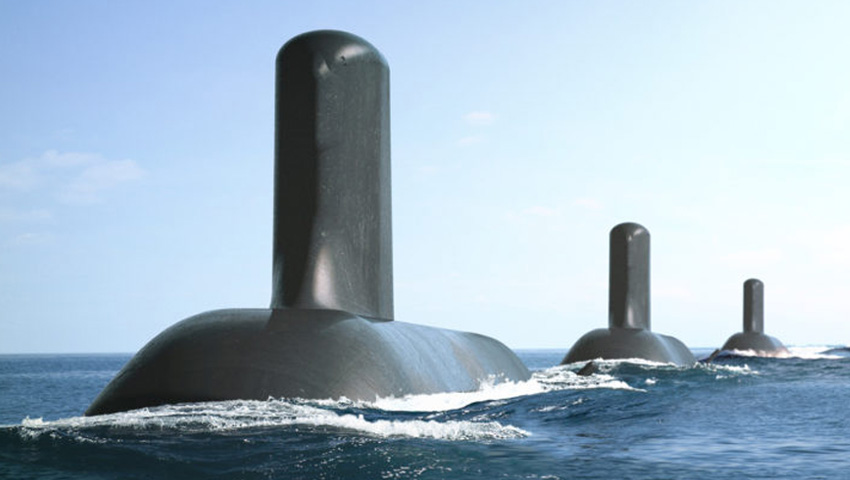Greg Moriarty, Secretary of the Department of Defence; Chief of Defence, General Angus Campbell, AO, DSC; Chief of Navy, Vice Admiral Mike Noonan, AO; and Tony Dalton, Deputy Secretary National Naval Shipbuilding have responded to the latest ANAO report into the SEA 1000 program.
To continue reading the rest of this article, please log in.
Create free account to get unlimited news articles and more!
It is the largest defence acquisition project in the history of the nation, but the apparently $50 billion project to replace the ageing Collins Class submarines with 12 regionally-superior submarines is in deep water.
Concerns about cost, capability and delivery time frame are again making headlines following the release of a troubling report from the Australian National Audit Office (ANAO) titled Future Submarine – Transition to design, building on the fallout from a fiery exchange at Senate estimates in late-2019.
To this end, Greg Moriarty, Secretary of the Department of Defence; Chief of Defence, General Angus Campbell, AO, DSC; Chief of Navy, Vice Admiral Mike Noonan, AO; and Tony Dalton, Deputy Secretary National Naval Shipbuilding have issued a rebuke to statements made in the media.
"Australia is fully committed to working with France and Naval Group to deliver the Attack Class Submarine fleet, which remains a strategically vital capability for our Defence Force into the future," the joint media statement articulates.
"The ANAO has previously reported that Defence effectively designed and implemented the process to select an international partner for the Attack Class Submarine Program (ANAO Report No.48 2016-17).
"Through a robust and comprehensive selection process, Defence determined that Naval Group was the most suitable partner to design and deliver a regionally superior submarine that will best meet our demanding capability requirements. Nothing has altered this assessment. Defence stands by this judgement."
Addressing concerns about Defence's requirements of "high levels of design maturity" for the successful design, Naval Group's Shortfin Barracuda, a conventionally powered variant of the nuclear-powered Barracuda Class submarines, the joint media statement said:
"Defence has continued to ensure that design of the Attack Class has progressed to the required high levels of design maturity, providing greater certainty that our capability requirements will be met, and avoiding costly and lengthy delays that would otherwise eventuate during the construction phase of the program.
"While the first scheduled major milestone under the Submarine Design Contract was reached five weeks later than planned, Defence and Naval Group are working towards the recovery of this delay by the next contracted major milestone in January 2021. Importantly, the delivery of the Attack Class submarine has not been delayed."
Remaining upbeat about the circumstances, the joint media release added, "Acknowledging the scale of this program, we remain confident that our work on the Attack Class Submarine Program with Naval Group and Lockheed Martin Australia is progressing thoroughly and will result in the delivery of a regionally superior submarine capability for Australia from the early 2030s, establishing a truly sovereign capability as we maximise the involvement of Australian industry."
The joint media release also stressed the importance of maintaining a transparent relationship regarding the SEA 1000 program and emphasised that this will remain throughout the program, stating:
"Defence has remained open in reporting the high risks that accompany the Attack Class Submarine Program, and has been diligent in working with its industry partner to manage pressures. As many lessons from major projects clearly indicate, taking the time required to establish strong foundations at the earliest stages of the Attack Class Program will underpin our longer-term ability to deliver the Attack Class fleet to schedule."
The Attack Class submarines will be delivered as part of the $50 billion SEA 1000 Future Submarine program.
Naval Group will deliver 12 regionally-superior submarines to the Royal Australian Navy. Naval Group's successful Shortfin Barracuda design, which serves as the basis for the new Attack Class, is a conventionally-powered variant of the nuclear-powered Barracuda fast attack submarine currently under construction for the French Navy.
Lockheed Martin will provide the AN/BYG-1 combat control system, which provides an open-architecture submarine combat control system for analysing and tracking submarine and surface-ship contacts, providing situational awareness as well as the capability to target and employ torpedoes and missiles.
The 12 vessels will be built by Naval Group at a specialist submarine shipyard at Osborne, South Australia.
The Commonwealth government’s Australian Naval Infrastructure (ANI) program will support the development of the future submarine shipyards.
The Commonwealth government formally signed the strategic partnering agreement (SPA) with Naval Group in February 2019 ahead of confirming the final design specifications and requirements for the Attack Class submarines.
The Attack Class will enter service with the Royal Australian Navy at a time when 50 per cent of the world’s submarines will be operating in the Indo-Pacific region.
Stephen Kuper
Steve has an extensive career across government, defence industry and advocacy, having previously worked for cabinet ministers at both Federal and State levels.

 Login
Login








